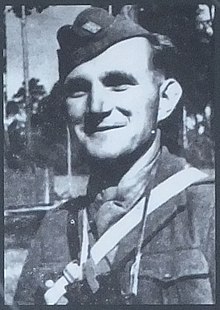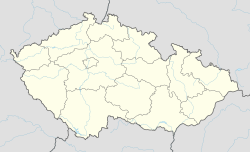1st Czechoslovak Partisan Brigade of Jan Žižka
| 1st Czechoslovak Partisan Brigade of Jan Žižka | |
|---|---|

Lieutenant Ján Ušiak, unit's 1st commander
|
|
| Active | 25 August 1944–26 May 1945 |
| Country |
|
| Type | Partisan Brigade |
| Role | Guerrilla warfare |
| Engagements | Battle of Štiavnik, Battle of Velké Karlovice |
| Commanders | |
| Commanders |
|
| Sklabiňa | |
|---|---|
| Coordinates: 49°02′45″N 19°00′14″E / 49.04583°N 19.00389°E |
| Čertův Mlýn | |
|---|---|
| Coordinates: 49°29′22″N 18°18′6″E / 49.48944°N 18.30167°E |
| Operation Grouse | |||||||||
|---|---|---|---|---|---|---|---|---|---|
| Part of German occupation of Czechoslovakia | |||||||||
|
|||||||||
| Belligerents | |||||||||
|
|
|
||||||||
| Commanders and leaders | |||||||||
|
|
|||||||||
| Strength | |||||||||
| 13 059 | ~ 200 | ||||||||
| Casualties and losses | |||||||||
| 6 men | 8 men | ||||||||
| D.B. Murzin was at the time wounded and not effectively in command, up to 40 civilian suspects were arrested and executed | |||||||||
The 1st Czechoslovak Partisan Brigade of Jan Žižka (Czech: 1. československá partizánská brigáda Jana Žižky), initially known as Ušiak-Murzin Unit, was the largest military unit conducting guerrilla warfare against the German occupation forces in the Protectorate of Bohemia and Moravia (modern day Czech Republic) during the Second World War.
The brigade was named after Jan Žižka, the 15th century leader of the Hussite army whose use of innovative techniques, such as the wagon fort and the large scale use of firearms, made him a Czech national hero. During the Second World War, there were two additional partisan formations that separately also used Jan Žižka's name: the Jan Žižka Moravskoslezský (formerly the Bílá Lvice resistance unit), operating further north in the Czech lands, and the Czechoslovak Brigade of Jan Žižka in Yugoslavia, operating in the Balkans.
When compared to the situation in some other occupied countries, conditions in the Czech part of Czechoslovakia, at that time occupied by Nazi Germany as the so-called "Protectorate of Bohemia and Moravia", did not favor guerrilla warfare. For one thing, there was a general shortage of firearms among the population. After Czechoslovakia yielded to British and French pressure and complied with the Munich agreement by surrendering the fortified border areas to Nazi Germany, Poland and Hungary, it withdrew its army away from the new frontiers. In March 1939, the Czechoslovak government yielded to German threats of aerial bombing. The army capitulated and the rest of the Czech lands (Bohemia, Moravia and part of Silesia) were occupied, while in the east the fascist Slovak government declared independence. The armaments of the Czechoslovak army were stored in army warehouses. Compared to other territories where warfare took place, there were very few guns available to the resistance movement, despite the relatively liberal firearms policies in place prior to the occupation. This lack of firearms would also prove critical during preparations for a coup, planned by the anti-Nazi resistance group Obrana národa, and later in the 1945 Prague uprising.
...
Wikipedia


